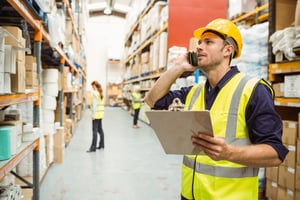The construction site is one of the most important areas in the workforce. For employees, it can also be a dangerous place for physical health. With new technology, construction professionals can monitor health on-site to prevent injuries or illnesses.
From mobile devices to drones, innovations show up in various ways to help. The industry remains a dangerous place, with somewhat high fatality and injury rates. Therefore, workers need the best protection they can get, and luckily, these advancements can provide it.
-
Mobile Devices
-
Virtual Reality
-
Wearables
-
Site Sensors
-
Drones
-
Health First On The Construction Site
Mobile Devices In The Workplace
Though OSHA has rules against cell phone use for specific construction practices, such as driving, some mobile devices can aid safety. They offer a variety of apps that workers can use to follow the safest protocols. Workers can also use the apps to report incidents or call for help should they need it.
 Some apps include things like project specs and details, documents about safety hazards, OSHA requirements, protocols and incident reports. Workers can access this information instantly and in a centralized location from their device. If someone needs guidance on how to handle machinery or the right protocols to take in dangerous situations, they can do so from the palm of their hand.
Some apps include things like project specs and details, documents about safety hazards, OSHA requirements, protocols and incident reports. Workers can access this information instantly and in a centralized location from their device. If someone needs guidance on how to handle machinery or the right protocols to take in dangerous situations, they can do so from the palm of their hand.
This connectivity reduces the risk of injury or fatality since people can access information and resources quickly. Workers will first need to check with OSHA guidelines before using mobile devices on all sites, however.
Virtual reality (VR) is a game-changer.
This innovation allows workers to simulate various situations they can put themselves into. If construction managers or supervisors use VR for training, workers will be able to reproduce the worksite and understand the hazards from a visual perspective.
Workers can identify risks in the virtual replication without any of the dangerous effects that come with them. Standard training can sometimes lack the engagement VR can bring to learning about the construction site. Since new equipment can boost employee productivity, introducing this tech is a wise investment for managers.
Some VR technology will allow for 360-degree training videos, and others offer a virtual hands-on approach. Whatever managers choose, training in this manner will boost engagement and educate workers on the importance of safety while on the job. From there, workplace incidents can decrease.
Wearable technology is a common feature of daily lives.
Smartwatches, for instance, are a hot commodity. Wearables can also help workers protect their health while on the job. With health tracking abilities, monitoring air quality and vitals, sensors, GPS and temperature detection, different wearables can go a long way for workers.
A smartwatch or smart hardhat can track standard vitals, for example. Then, they may even be equipped to help site managers take immediate action. For instance, workers sometimes expose themselves to hazardous materials and pollutants, like carbon monoxide. With wearables that can detect air quality, the alerts can notify them that their health is at risk. This technology is also helpful for working in extreme temperatures — warnings can encourage breaks and help prevent heat exhaustion.
Site sensors are similar to wearable technology.
However, they can encompass different abilities. Workers often deal with harsh climates and harmful materials. Summer is a popular time for building, but it can take a toll on workers.
Like wearables, site sensors can detect carbon monoxide instantly. They can also monitor temperatures and alert workers when they reach dangerous levels that require additional protection. Detecting harmful substances like asbestos will also be invaluable for workers.
Installing these developments at construction sites will reduce risks and incidents. Worker health is of the utmost importance — prevention is better than treatment. Taking precautionary actions, like using sensors, can reduce healthcare costs for everyone involved.
Drones are now a standard part of construction site practices.
They're most helpful for monitoring and inspecting certain areas of a site. Workers can control them to fly up high and inspect any areas that may need repairs or replacements. With high-quality cameras for images and videos, drones can take care of maintenance checks quickly.
These steps are helpful for workers' safety and health since they would need to complete inspections otherwise.
During maintenance is when falls and serious injuries primarily occur, especially with elevated sites. Drones are a safer alternative to prevent these incidents.
Construction is always in high demand around the world. Workers will meet demands, but managers and supervisors must ensure everyone has the safest technology for their health. With these innovations, employees can put their health first while still accomplishing what they need to.
 Holly Welles is a writer focusing on construction and real estate. Her work on safety and technology has been published in Construction Executive, Constructible and other online publications. Learn more about her work via her website, The Estate Update.
Holly Welles is a writer focusing on construction and real estate. Her work on safety and technology has been published in Construction Executive, Constructible and other online publications. Learn more about her work via her website, The Estate Update.





Leave a Comment